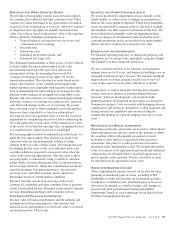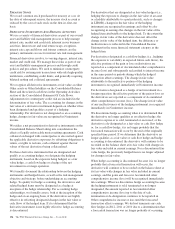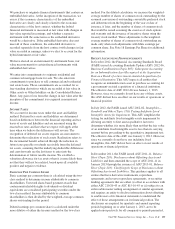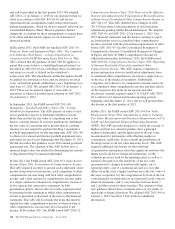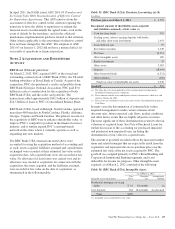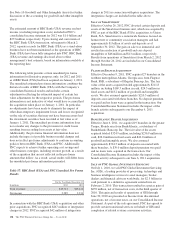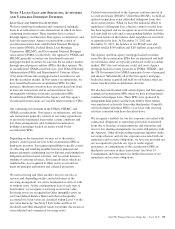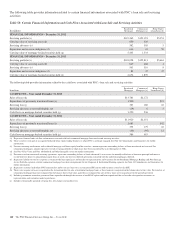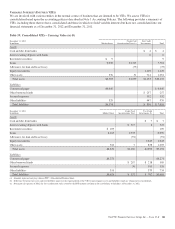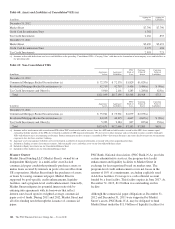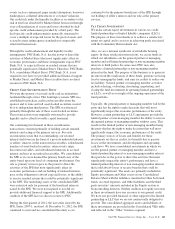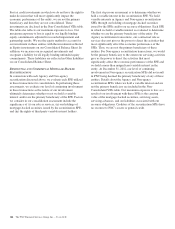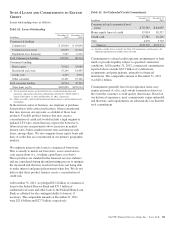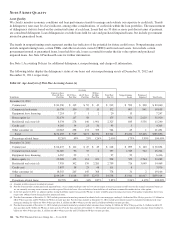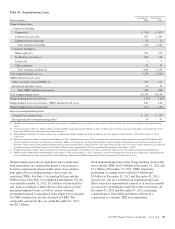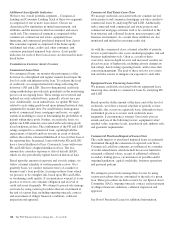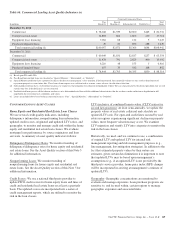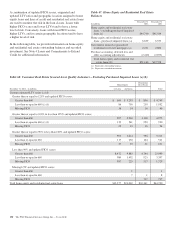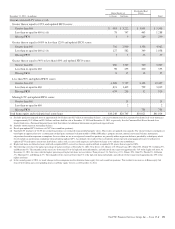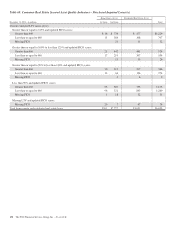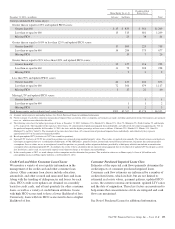PNC Bank 2012 Annual Report Download - page 162
Download and view the complete annual report
Please find page 162 of the 2012 PNC Bank annual report below. You can navigate through the pages in the report by either clicking on the pages listed below, or by using the keyword search tool below to find specific information within the annual report.events such as commercial paper market disruptions, borrower
bankruptcies, collateral deficiencies or covenant violations.
Our credit risk under the liquidity facilities is secondary to the
risk of first loss absorbed by Market Street borrowers through
over-collateralization of assets and losses absorbed by deal-
specific credit enhancement provided by a third party. The
deal-specific credit enhancement is generally structured to
cover a multiple of expected losses for the pool of assets and
is sized to meet rating agency standards for comparably
structured transactions.
Through the credit enhancement and liquidity facility
arrangements, PNC Bank, N.A. has the power to direct the
activities of Market Street that most significantly affect its
economic performance and these arrangements expose PNC
Bank, N.A. to expected losses or residual returns that are
potentially significant to Market Street. Therefore, PNC Bank,
N.A. consolidates Market Street. PNC Bank, N.A. is not
required to nor have we provided additional financial support
to Market Street, and Market Street creditors have no direct
recourse to PNC Bank, N.A.
C
REDIT
C
ARD
S
ECURITIZATION
T
RUST
We were the sponsor of several credit card securitizations
facilitated through a trust. This bankruptcy-remote SPE was
established to purchase credit card receivables from the
sponsor and to issue and sell asset-backed securities created
by it to independent third-parties. The SPE was financed
primarily through the sale of these asset-backed securities.
These transactions were originally structured to provide
liquidity and to afford favorable capital treatment.
Our continuing involvement in these securitization
transactions consisted primarily of holding certain retained
interests and acting as the primary servicer. For each
securitization series that was outstanding, our retained
interests held were in the form of a pro-rata undivided interest,
or sellers’ interest, in the transferred receivables, subordinated
tranches of asset-backed securities, interest-only strips,
discount receivables, and subordinated interests in accrued
interest and fees in securitized receivables. We consolidated
the SPE as we were deemed the primary beneficiary of the
entity based upon our level of continuing involvement. Our
role as primary servicer gave us the power to direct the
activities of the SPE that most significantly affect its
economic performance and our holding of retained interests
gave us the obligation to absorb expected losses, or the ability
to receive residual returns that could be potentially significant
to the SPE. The underlying assets of the consolidated SPE
were restricted only for payment of the beneficial interests
issued by the SPE. We were not required to nor did we
provide additional financial support to the SPE. Additionally,
creditors of the SPE have no direct recourse to PNC.
During the first quarter of 2012, the last series issued by the
SPE, Series 2007-1, matured. At December 31, 2012, the SPE
continued to exist and we consolidated the entity as we
continued to be the primary beneficiary of the SPE through
our holding of seller’s interest and our role as the primary
servicer.
T
AX
C
REDIT
I
NVESTMENTS
We make certain equity investments in various tax credit
limited partnerships or limited liability companies (LLCs).
The purpose of these investments is to achieve a satisfactory
return on capital and to assist us in achieving goals associated
with the Community Reinvestment Act.
Also, we are a national syndicator of affordable housing
equity. In these syndication transactions, we create funds in
which our subsidiaries are the general partner or managing
member and sell limited partnership or non-managing member
interests to third parties. In some cases PNC may also
purchase a limited partnership or non-managing member
interest in the fund. The purpose of this business is to generate
income from the syndication of these funds, generate servicing
fees by managing the funds, and earn tax credits to reduce our
tax liability. General partner or managing member activities
include selecting, evaluating, structuring, negotiating, and
closing the fund investments in operating limited partnerships
or LLCs, as well as oversight of the ongoing operations of the
fund portfolio.
Typically, the general partner or managing member will be the
party that has the right to make decisions that will most
significantly impact the economic performance of the entity.
However, certain partnership or LLC agreements provide the
limited partner or non-managing member the ability to remove
the general partner or managing member without cause. This
results in the limited partner or non-managing member being
the party that has the right to make decisions that will most
significantly impact the economic performance of the entity.
The primary sources of losses and benefits for these
investments are the tax credits, tax benefits due to passive
losses on the investments, and development and operating
cash flows. We have consolidated investments in which we
are the general partner or managing member and have a
limited partnership interest or non-managing member interest
that provides us the power to direct the activities that most
significantly impact the entity’s performance and have a
limited partnership interest or non-managing member interest
that could absorb losses or receive benefits that could be
potentially significant. The assets are primarily included in
Equity investments and Other assets on our Consolidated
Balance Sheet with the liabilities classified in Other borrowed
funds, Accrued expenses, and Other liabilities and the third
party investors’ interests included in the Equity section as
Noncontrolling interests. Neither creditors nor equity investors
in these investments have any recourse to our general credit.
We have not provided financial or other support to the limited
partnership or LLC that we are not contractually obligated to
provide. The consolidated aggregate assets and liabilities of
these investments are provided in the Consolidated VIEs table
and reflected in the “Other” business segment.
The PNC Financial Services Group, Inc. – Form 10-K 143


